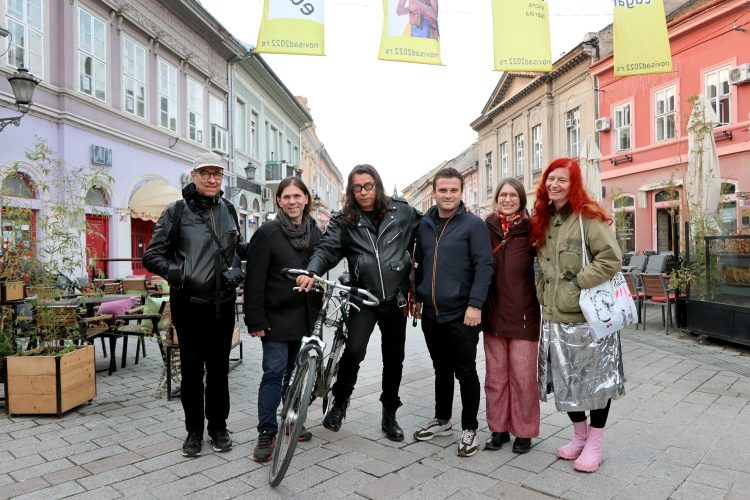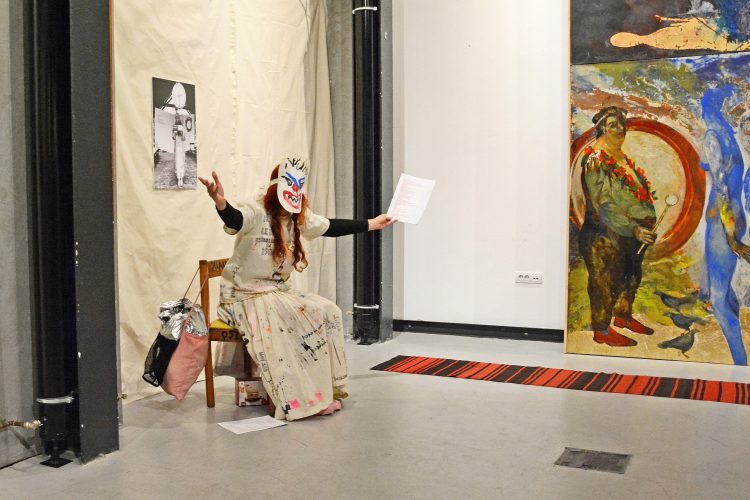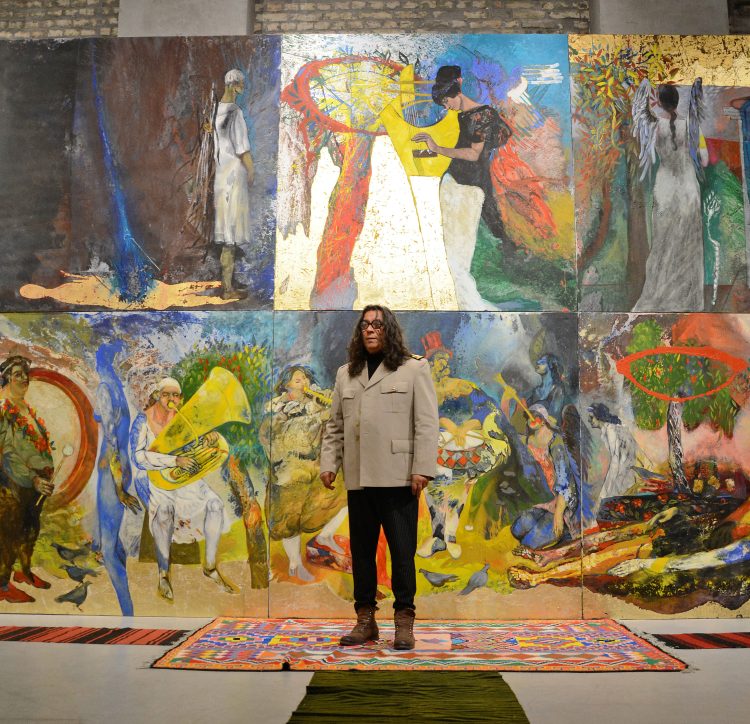A Parable on Europe and the Roma

Sead Kazanxhiu, Zoran Tairović, Delaine Le Bas and Nikad Nino Pušija in front of Zoran Tairović’s work. Photo: Matthias Reichelt
10 November 2022, Day One
I am having a cup of coffee outside the Svilara Cultural Station. And I think to myself, there are all kinds of stations. This one is about waiting. What are you waiting for? For something to transpose me into a new reality. I am thinking about the concept of the exhibition, The Other Side of the Image, and the man behind it, Vladan. A little later a bus from Belgrade pulls in. I am surprised by the number of passengers, who have obviously come for the opening, and I realize it can’t be a failure. I am sipping my coffee and think about what has been done in the gallery.
The inherited helplessness of such events convinces me that, on the evidence of existing historical overviews and the few critical reviews of Roma artists’ exhibitions, it will be necessary to analyse, in a critically polemical context, the contradictions of the European system of cultural values in a space marked by nation states’ dogmatic ideologies and all the complexities in their interactions that further obscure the already blurred image of art.
To the extent that it is realistic to think of Roma art, it has political implications for the reception of modern art. The odds of this happening are, to quantify them, zero or slightly less. That’s an idea I put aside, as it doesn’t really make sense to think like that before the very opening of the exhibition.
Roma artists are not a privileged group. Elite art criticism imperatively advocates hidden corporate ideas, believing that the trend is what guarantees their legitimacy, while it casts them into the gallery shadow of art management. In the revisionist circle in my mind, Roma artists with half an idea stand and watch as critics are chasing their art historian tails. In this case, when I refer to the elite, I have in mind corporate packages of artefacts that are of no interest to any of the interested parties on an aesthetic level, but solely as a measure of value. Art and artworks in terms of profit. It occurs to me that I am currently far away from such an attitude. When I enrolled in art college, I thought that talent was the affirmation of art. There are now a lot of people outside the gallery, including some from Novi Sad. I enter the gallery, where the exhibition is open.
11 November 2022, Day Two, the day after…
To understand such an installation, it is essential that this philosophical approach does not speak of a single line of development of Roma art on European soil. A chronological approach, which would trace a presence of 700 years—more precisely, from the foundation of the Neapolitan school of painting by Antonio Solario, aka ‘Lo Zingaro’—would soften the edge of this very aggressive and ominous, somewhat revolutionary approach to the exhibition concept, because a host of other, different genealogies and narratives are possible, which, rather than omitted, are emphasized this time. (See the installation of British artist Delaine Le Bas, Moscow Cut, or, Geopolitical Apotheosis.) Here we seek to single out and emphasize certain changes in linguistic paradigms in art, which were mostly spawned by ‘Sweet Life’ hunters who, through war, turned their backs on all things creative (all that is not destruction and war). I walk around the gallery and look at Sead Kazanxhiu’s installation.
Significant individuals, artists who ushered in the spirit of experimentation, as well as faith in the idea of progress, in the relationship towards pictoriality, the plastic sign, form, representation, material, theoretical models, the synthesis of all forms of art and other elements of the construction of a work of art, came together in the installation, in Sead’s sculpture. This sets the first and basic premise of The Other Side of the Image, the exhibition dedicated to invisible artists—invisible as a result of seven centuries of ignoring the existence of the term Roma Artist. I have a feeling that this is a work dedicated to the army of unnamed and unjustly hidden artists who were confined to oblivion by the veil of historical fog and thus mysteriously pushed from the scene; the ones, who, with their experiments and commitment in art and craftsmanship on the European soil, laid the foundations of a new visual language in the context of European cultural heritage. We took on a job of great responsibility and difficulty… I walk around and hum, carefree in the space of the reconstructed hell of hidden artworks.
One of the key starting points for the exhibition is the concept of contemporaneity, discontinuity with national art, as well as the generation of new artistic languages and ideologies within a sociopolitical social experiment. The authors of this exhibition manifested European tendencies by pinpointing and supporting the Roma identity apparatus, with a goal of an active and programmatically antagonistic, reaffirmed positioning of the art of Roma creators against the dominant ideological models in culture. It is not clear to me how a Roma identity apparatus is created. Not that it matters…

Matthias Reichelt, Vladan Jeremić, Zoran Tairović, Sead Kazanxhiu, Rena Raedle, Delaine Le Bas. Photo: Nihad Nino Pušija
12 November 2022, Day Three
Before I doze off, I remember Eugène Delacroix’s Dante and Virgil in Hell, a painting that marked a departure from academic classicism towards a new romanticism, all in the service of free artistic expression. He rehabilitated colour, and by doing so he foreshadowed impressionism. Eugène, what a visionary… What was he thinking when he managed to depersonalize Byron’s vicious competition with nature and to anticipate Otto Müller? A direct collision between nature and transcendence. I imagine what future reviews of the exhibition might look like:
‘Determined by the historical, political, sociocultural and artistic conditions of the wider (European) and narrower (Serbian) environment, the exhibition The Other Side of the Image was articulated at the transition between the second and third decades of the 21st century. Together with the curator Vladan Jeremić, the critic, the four artists—Delaine Le Bas, Zoran Tairović, Nihad Nino Pušija, Sead Kazanxhiu—created poetics and ideology in the space of revisionism and formed the nucleus of the new movement. It is an anti-aesthetic theory based on the research of historical material through thought experiments, i.e. the application of the science of art in the service of operational procedures through which the paradigmatic destruction of the classical form of art history took place. Such treatment in the design of this exhibition represented a subversion of dominant aesthetic and ideological matrices, implied subjective, provocative, critical content and meant a rebellion against the current situation in European art, culture, society, and politics.’
This exhibition is registered in the cosmic records that are not nature. I go to sleep in the hope of talking to Dante and Virgil.

A performance of Delaine Le Bas at the opening of “The Other Side of the Image”, Svilara Cultural Station, Novi Sad (November 10). Photo: Snežana Lerh
13 November 2022, Day Four
This exhibition, which laid the foundation for the theme in the space of revisionism, is contemporary in its character, which according to the understanding of the ‘four European painters’ is possible only if it has a European, that is, world and international orientation. I say that optimistically, of course: four European painters, an Englishwoman, a German, admittedly with a Sarajevan genotype, I, a Serb, a European, completely one when we can join the EU, and an Albanian. Wow, it’s almost like a joke… A Serb, an Albanian, a Bosnian German and an Englishwoman meet, that’s enough for a joke.
In the limited ‘gallery’ space of the Svilara, it was not possible to make a thorough analysis of key events in an artificial arrangement. Also, the space does not permit the creation of elaborate constellations, based on broader themes and problems, nor the grouping or isolation of specific artistic phenomena. And finally, it was not possible to present some of the key, large-format works of the ‘four artists,’ specifically the sculptures. With space limitations determining the arrangement, the idea was to dedicate each room, or ‘station,’ to a single premise. On a symbolic level, it reads ‘Revision of the History of Art “On the Other Side of the Image.”’ It’s not a joke. It is reality.
14 November 2022, Day Five
It’s raining. I am making celery pasta. I bought pasta at the Fish Market from a Zuska (Slovak woman). It tastes better than Barilla. I am standing by the stove, listening to the news from Ukraine. I have a vision of people’s faces like those in Picasso’s Guernica. I feel sorry for those people and for Nino Pušija, who paid for his majestic work with deep scars on his camera lens. In this exhibition, he presented the miracles of his blemished lens, which bear witness to the dramatic scenes of Sarajevo during the war, to himself in Europe, where he amplified his artistic existence by depicting a horrendous plight. Two topics come to mind, suffering and guilt. I am thinking about the Roma. The historical context in which the revisionist space ‘on the other side of the image’ was created has been marked by events in the world’s political, spiritual and artistic spheres, which are precisely reflected in the socio-political and cultural circumstances in an environment affected by the war in Europe (the Russian–Ukrainian conflict), where a Eurocentric attitude largely determines the positions of the EU countries, frustrated and burdened by existential and energy issues, lacking an interest in their own status in culture and art. The Other Side of the Image is a space that reaffirms all that has been missed and left unmentioned for seven centuries. It represents a highly controversial, polemical reception of art criticism. And so, in the third decade of the 21st century, a space ‘on the other side of the image’ is opened to reaffirm all that civilization destroyed—while it justified its position by the defeats it placed in the showcases of the winners, although we all know these are the remnants that survived the destruction. To a large extent, museums are our reminders of historical defeats, displaying remains that the ideologues gathered from the bloody soil, polished and stylishly framed. Closely following the work of our protagonists, the ‘four European painters,’ and taking part in the theoretical elaboration of their poetics, Vladan Jeremić, a ‘militant’ critic, made a substantial contribution to the ideology ‘behind the picture,’ to its articulation as a coherent movement. His agility in promotion and organization was key to the realization of this programmatic appearance in the Svilara gallery. Instead of having an aesthetic focus, the exhibition is a kind of indicator of critical thinking about aesthetics and the ethical attitude of the artists, revealing at the same time their mentality. In this way, the morphological and ideological matrix of the highly modernist ‘picture of the world,’ tied to a package of corporate synergy and deals with Europe, i.e. corporate art, which does not have a Roma element in art—because Roma art could never be transposed into the official sphere of culture, society and ideology—was systematically undermined. We can sense that the art of Roma creators is subversive, has an inherent revolutionary spirit whose basic postulate is a revisionist space in which it could speak without fear, mimicry, or being judged by conservative ideologies. The water is boiling and my pasta is ready. It is going to be a good lunch. I turn off the news. Barili is a great painter. Oh, dear Milena.
16 November 2022, Day Six
I was sitting in the Laterna, where they serve excellent coffee, discussing the Svilara exhibition with a journalist. PLAY. He recorded the conversation. The following is a direct transcript. ‘This exhibition revealed that art, in addition to its basic narrative and function, may play a crucial role in the development of art practice. “Four artists behind the painting” present a better insight into how the political context changes and what actually takes place in the geopolitical body when there are anomalies in the development process. This specifically means that after this exhibition, artists will now be able to more easily create “artificial tissue of artworks and organs to imagine new artistic practices in laboratory conditions,” which can further lead them to even greater insights into the living world of hidden facts in the space of the European system of cultural values.’ That was my conclusion. Or was it? GAME.

Zoran Tairović in front of his work at the opening of “The Other Side of the Image” exhibiton, Svilara Cultural Station, Novi Sad (November 10). Photo: Snežana Lerh
17 November 2022, Day Seven
I am strolling along the Novi Sad quay. I run into a wonderful man. We recall an unpleasant event from way back when. My friend, an emeritus professor, once spoke about acculturation at a conference in Prague. Themes that carved the Roma into the European cultural matrices. It was a long time ago. I also spoke, not so successfully, about the Roma and Heidegger. The emeritus professor was verbally assaulted by an English professor. I was speechless. My friend, the emeritus professor, shouted: ‘I know the difference between PLAY and GAME, I have had enough of you, language rapists.’ I took a long walk along the quay. The Other Side of the Image represents a completely new artificial form. Its name derives from the conscious omission of the prefix ‘Roma,’ which on a symbolic level refers to the essential, participatory/historical part of the amputated body, which, in the process of creating a European identity clone, became a great enigma to creativity itself. It has been revealed by artists ‘without a chance,’ who did their research feeling deep inside that they were ‘hidden and irrelevant’ and that this permanently defined a new way of reading the history of art, the science of art, the philosophy of art. It is important to note that, although revisionism, as well as its space, is important for the new thought about discontinuity, this form ‘on the other side of the image’ was unknown or poorly defined to artists, to the Roma, for hundreds of years. The Romani, the creator, the artist, was often defined as a structure in the form of a ‘prism or pyramid of conspiracies’ of the national ideologies that allowed Roma appearances to meander in artificial invisible rivers of abysses while the European bridges over the same chasms functionally supported the artists and historical art funds of the national elites, and which today are proof of the defeat of what was destroyed in the visible political rivers of Europe. Perhaps the Roma should, as the emeritus professor did, shout loud and clear: ‘We know the difference between PLAY and GAME, we have had enough of you, language rapists.’
Text by Zoran Tairović
Translated from Serbian by Marija Cikes
Edited by Árpád Mihály
The Other Side of the Image
Artists: Delaine La Bas, Sead Kazanxhiu, Nihad Nino Pušija, Zoran Tairović.
Curator: Vladan Jeremić
12 November 2022- 6 December 2022
Svilara Cultural Station, Novi Sad, Serbia


Leave a Reply